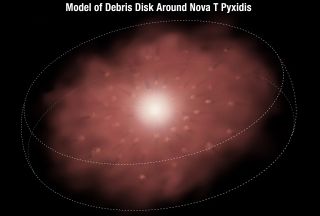 An updated version of this paper appeared on arXiv March 5, 2014.
An updated version of this paper appeared on arXiv March 5, 2014.
Despite being the prototype of its class, T Pyx is arguably the most unusual and poorly understood recurrent nova. Here, we use radio observations from the Karl G. Jansky Very Large Array to trace the evolution of the ejecta over the course of the 2011 outburst of T Pyx. The radio emission is broadly consistent with thermal emission from the nova ejecta. However, the radio flux began rising surprisingly late in the outburst, indicating that the bulk of the radio-emitting material was either very cold, or expanding very slowly, for the first ~50 days of the outburst. Considering a plausible range of volume filling factors and geometries for the ejecta, we find that the high peak flux densities of the radio emission require a massive ejection of 1-30 x 10^{-5} solar masses. This ejecta mass is much higher than the values normally associated with recurrent novae, and is more consistent with a nova on a white dwarf well below the Chandrasekhar limit.
Authors: Thomas Nelson, Laura Chomiuk, Nirupam Roy, J. L. Sokoloski, Koji Mukai, Miriam I. Krauss, Amy J. Mioduszewski, Michael P. Rupen, Jennifer Weston

